Stephen J. Skripak; Anastasia Cortes; and Anita Walz
Learning Objectives
- Identify the three levels of management and the responsibilities at each level.
- Discuss various options for organizing a business, and create an organization chart.
- Understand how specialization helps make organizations more efficient.
- Discuss the different ways that an organization can departmentalize.
- Explain other key terms related to this chapter such as chain of command, delegation of authority, and span of control.
Organizing
If you read our chapter on Management and Leadership, you will recall developing a strategic plan for your new company, Notes-4-You. Once a business has completed the planning process, it will need to organize the company so that it can implement that plan. A manager engaged in organizing allocates resources (people, equipment, and money) to achieve a company’s objectives. Successful managers make sure that all the activities identified in the planning process are assigned to some person, department, or team and that everyone has the resources needed to perform assigned activities.
Levels of Management: How Managers Are Organized
A typical organization has several layers of management. Think of these layers as forming a pyramid like the one in Figure 9.1, with top managers occupying the narrow space at the peak, first-line managers the broad base, and middle-managers the levels in between. As you move up the pyramid, management positions get more demanding, but they carry more authority and responsibility (along with more power, prestige, and pay). Top managers spend most of their time in planning and decision making, while first-line managers focus on day-to-day operations. For obvious reasons, there are far more people with positions at the base of the pyramid than there are at the other two levels. Let’s look at each management level in more detail.
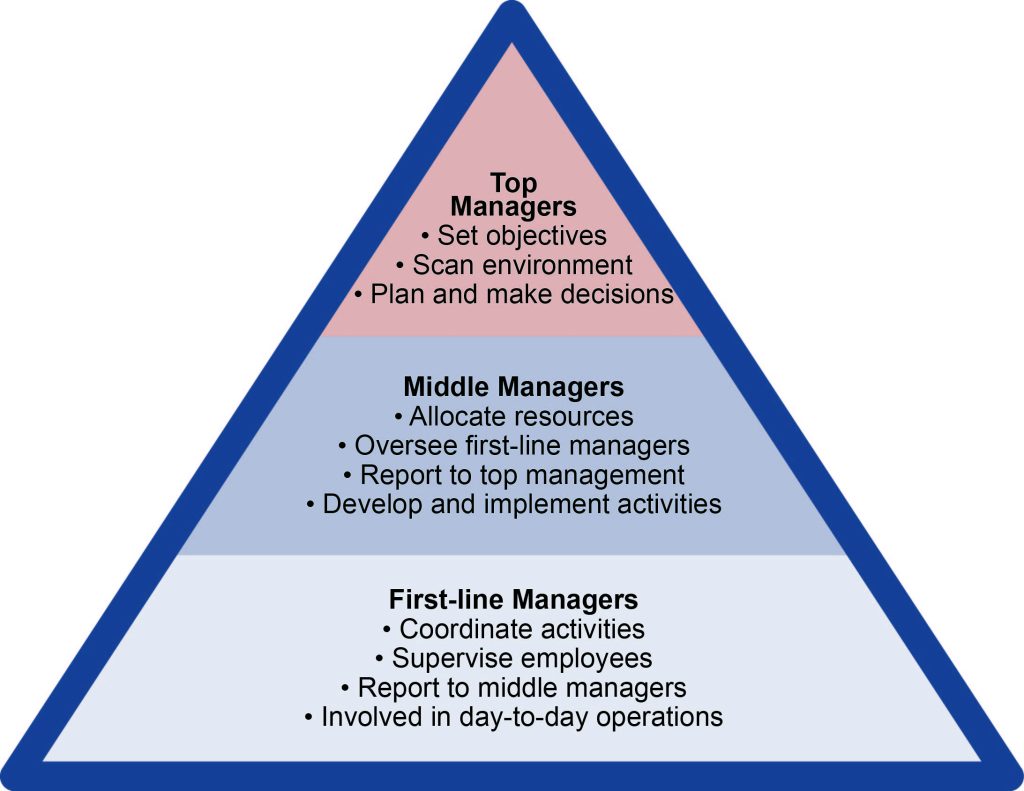
Top Managers
Top managers are responsible for the health and performance of the organization. They set the objectives, or performance targets, designed to direct all the activities that must be performed if the company is going to fulfill its mission. Top-level executives routinely scan the external environment for opportunities and threats, and they redirect company efforts when needed. They spend a considerable portion of their time planning and making major decisions. They represent the company in important dealings with other businesses and government agencies, and they promote it to the public. Job titles at this level typically include chief executive officer (CEO), chief financial officer (CFO), chief operating officer (COO), president, and vice president.
Middle Managers
Middle managers are in the center of the management hierarchy: they report to top management and oversee the activities of first-line managers. They’re responsible for developing and implementing activities and allocating the resources needed to achieve the objectives set by top management. Common job titles include operations manager, division manager, plant manager, and branch manager.
First-Line Managers
First-line managers supervise employees and coordinate their activities to make sure that the work performed throughout the company is consistent with the plans of both top and middle management. It’s at this level that most people acquire their first managerial experience. The job titles vary considerably but include such designations as manager, group leader, office manager, foreman, and supervisor.
Let’s take a quick survey of the management hierarchy at Notes-4-You. As president, you are a member of top management, and you’re responsible for the overall performance of your company. You spend much of your time setting performance targets, to ensure that the company meets the goals you’ve set for it— increased sales, higher-quality notes, and timely distribution.
Several middle managers report to you, including your operations manager. As a middle manager, this individual focuses on implementing two of your objectives: producing high-quality notes and distributing them to customers in a timely manner. To accomplish this task, the operations manager oversees the work of two first-line managers—the note-taking supervisor and the copying supervisor. Each first-line manager supervises several non-managerial employees to make sure that their work is consistent with the plans devised by top and middle management.
Organizational Structure: How Companies Get the Job Done
Building an organizational structure engages managers in two activities: job specialization (dividing tasks into jobs) and departmentalization (grouping jobs into units). An organizational structure outlines the various roles within an organizational, which positions report to which, and how an organization will departmentalize its work. Take note than an organizational structure is an arrangement of positions that’s most appropriate for your company at a specific point in time. Given the rapidly changing environment in which businesses operate, a structure that works today might be outdated tomorrow. That’s why you hear so often about companies restructuring—altering existing organizational structures to become more competitive once conditions have changed. Let’s now look at how the processes of specialization and departmentalization are accomplished.
Specialization
Organizing activities into clusters of related tasks that can be handled by certain individuals or groups is called specialization. This aspect of designing an organizational structure is twofold:
- Identify the activities that need to be performed in order to achieve organizational goals.
- Break down these activities into tasks that can be performed by individuals or groups of employees.
Specialization has several advantages. First and foremost, it leads to efficiency. Imagine a situation in which each department was responsible for paying its own invoices; a person handling this function a few times a week would likely be far less efficient than someone whose job was to pay the bills. In addition to increasing efficiency, specialization results in jobs that are easier to learn and roles that are clearer to employees. But the approach has disadvantages, too. Doing the same thing over and over sometimes leads to boredom and may eventually leave employees dissatisfied with their jobs. Before long, companies may notice decreased performance and increased absenteeism and turnover (the percentage of workers who leave an organization and must be replaced).
Departmentalization
The next step in designing an organizational structure is departmentalization—grouping specialized jobs into meaningful units. Depending on the organization and the size of the work units, they may be called divisions, departments, or just plain groups.
Traditional groupings of jobs result in different organizational structures, and for the sake of simplicity, we’ll focus on two types—functional and divisional organizations.
Functional Organizations
A functional organization groups together people who have comparable skills and perform similar tasks. This form of organization is fairly typical for small to medium-size companies, which group their people by business functions: accountants are grouped together, as are people in finance, marketing and sales, human resources, production, and research and development. Each unit is headed by an individual with expertise in the unit’s particular function. Examples of typical functions in a business enterprise include human resources, operations, marketing, and finance. Also, business colleges will often organize according to functions found in a business.
There are a number of advantages to the functional approach. The structure is simple to understand and enables the staff to specialize in particular areas; everyone in the marketing group would probably have similar interests and expertise. But homogeneity also has drawbacks: it can hinder communication and decision making between units and even promote interdepartmental conflict. The marketing department, for example, might butt heads with the accounting department because marketers want to spend as much as possible on advertising, while accountants want to control costs.
Divisional Organizations
Large companies often find it unruly to operate as one large unit under a functional organizational structure. Sheer size makes it difficult for managers to oversee operations and serve customers. To rectify this problem, most large companies are structured as divisional organizations. They are similar in many respects to stand-alone companies, except that certain common tasks, like legal work, tends to be centralized at the headquarters level. Each division functions relatively autonomously because it contains most of the functional expertise (production, marketing, accounting, finance, human resources) needed to meet its objectives. The challenge is to find the most appropriate way of structuring operations to achieve overall company goals. Toward this end, divisions can be formed according to products, customers, processes, or geography.
Product Divisions
Product division means that a company is structured according to its product lines. General Motors, for example, has four product-based divisions: Buick, Cadillac, Chevrolet, and GMC.1 Each division has its own research and development group, its own manufacturing operations, and its own marketing team. This allows individuals in the division to focus all their efforts on the products produced by their division. A downside is that it results in higher costs as corporate support services (such as accounting and human resources) are duplicated in each of the four divisions.
Customer Divisions
Some companies prefer a customer division structure because it enables them to better serve their various categories of customers. Thus, Johnson & Johnson’s two hundred or so operating companies are grouped into three customer-based business segments: consumer business (personal-care and hygiene products sold to the general public), pharmaceuticals (prescription drugs sold to pharmacies), and professional business (medical devices and diagnostics products used by physicians, optometrists, hospitals, laboratories, and clinics).2
Process Divisions
If goods move through several steps during production, a company might opt for a process division structure. This form works well at Bowater Thunder Bay, a Canadian company that harvests trees and processes wood into newsprint and pulp. The first step in the production process is harvesting and stripping trees. Then, large logs are sold to lumber mills and smaller logs are chopped up and sent to Bowater’s mills. At the mill, wood chips are chemically converted into pulp. About 90 percent is sold to other manufacturers (as raw material for home and office products), and the remaining 10 percent is further processed into newspaper print. Bowater, then, has three divisions: tree cutting, chemical processing, and finishing (which makes newsprint).3
Geographical Divisions
Geographical division enables companies that operate in several locations to be responsive to customers at a local level. Adidas, for example, is organized according to the regions of the world in which it operates. They have eight different regions, and each one reports its performance separately in their annual reports.4
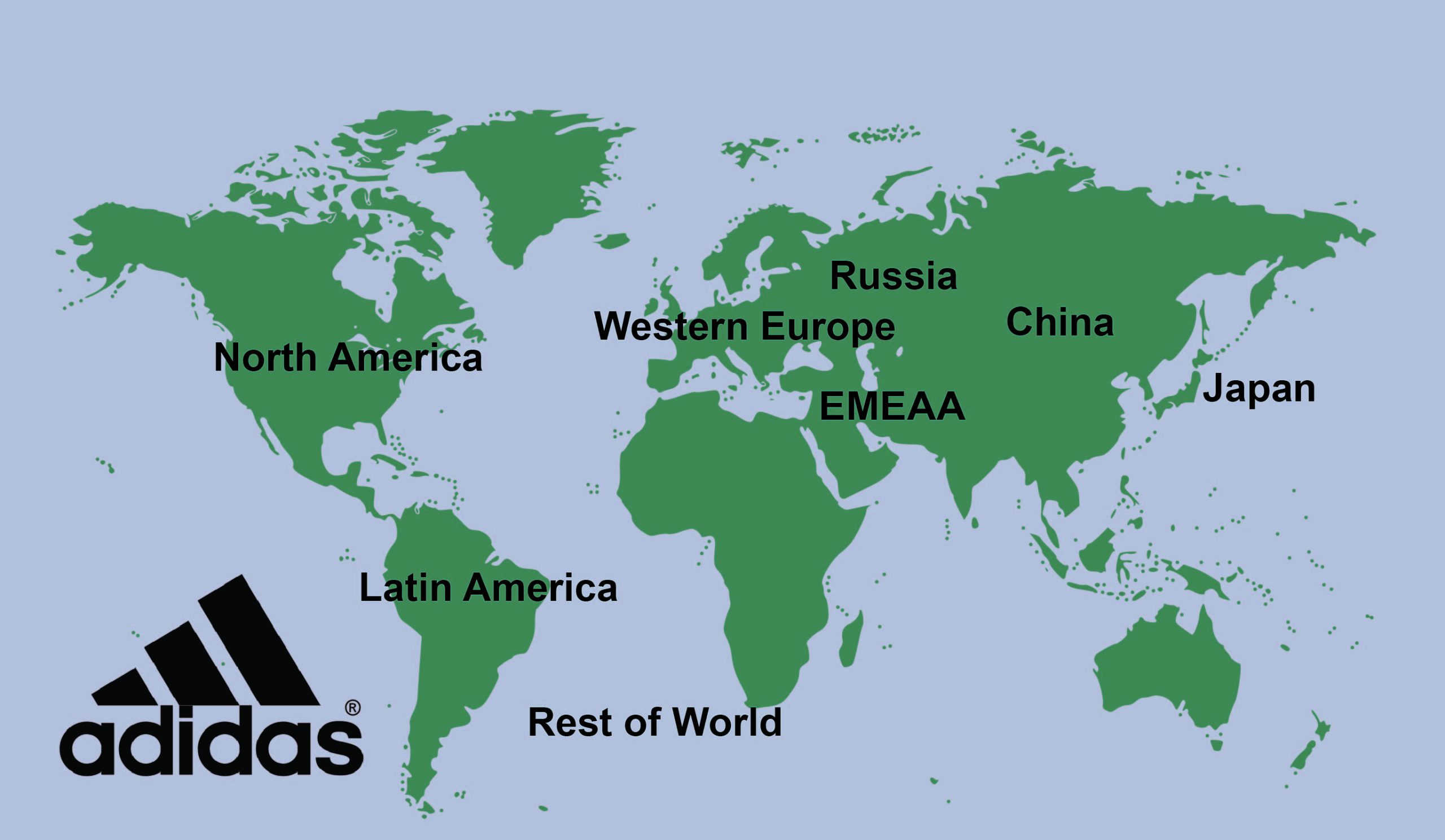
Summing Up Divisional Organizations
There are pluses and minuses associated with divisional organization. On the one hand, divisional structure usually enhances the ability to respond to changes in a firm’s environment. If, on the other hand, services must be duplicated across units, costs will be higher. In addition, some companies have found that units tend to focus on their own needs and goals at the expense of the organization as a whole.
The Organization Chart
Once an organization has set its structure, it can represent that structure in an organization chart: a diagram delineating the interrelationships of positions within the organization. An example organization chart is shown in Figure 9.3, using our “Notes-4-You” example from Chapter 8.
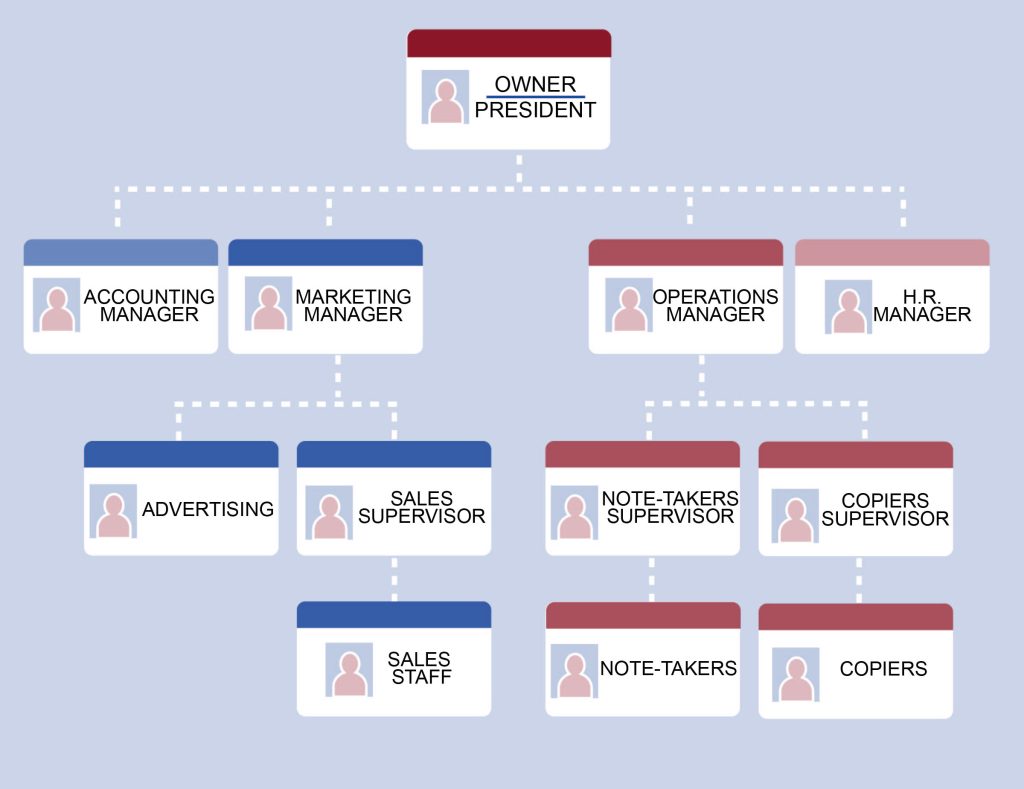
Imagine putting yourself at the top of the chart, as the company’s president. You would then fill in the level directly below your name with the names and positions of the people who work directly for you—your accounting, marketing, operations, and human resources managers. The next level identifies the people who work for these managers. Because you’ve started out small, neither your accounting manager nor your human resources manager will be currently managing anyone directly. Your marketing manager, however, will oversee one person in advertising and a sales supervisor (who, in turn, oversees the sales staff). Your operations manager will oversee two individuals—one to supervise note-takers and one to supervise the people responsible for making copies. The lines between the positions on the chart indicate the reporting relationships; for example, the Note-Takers Supervisor reports directly to the Operations Manager.
Although the structure suggests that you will communicate only with your four direct reports, this isn’t the way things normally work in practice. Behind every formal communication network there lies a network of informal communications—unofficial relationships among members of an organization. You might find that over time, you receive communications directly from members of the sales staff; in fact, you might encourage this line of communication.
Now let’s look at the chart of an organization that relies on a divisional structure based on goods or services produced—say, a theme park. The top layers of this company’s organization chart might look like the one in Figure 9.4a (left side of the diagram). We see that the president has two direct reports—a vice president in charge of rides and a vice president in charge of concessions. What about a bank that’s structured according to its customer base? The bank’s organization chart would begin like the one in Figure 9.4b. Once again, the company’s top manager has two direct reports, in this case a VP of retail-customer accounts and a VP of commercial-customer accounts.
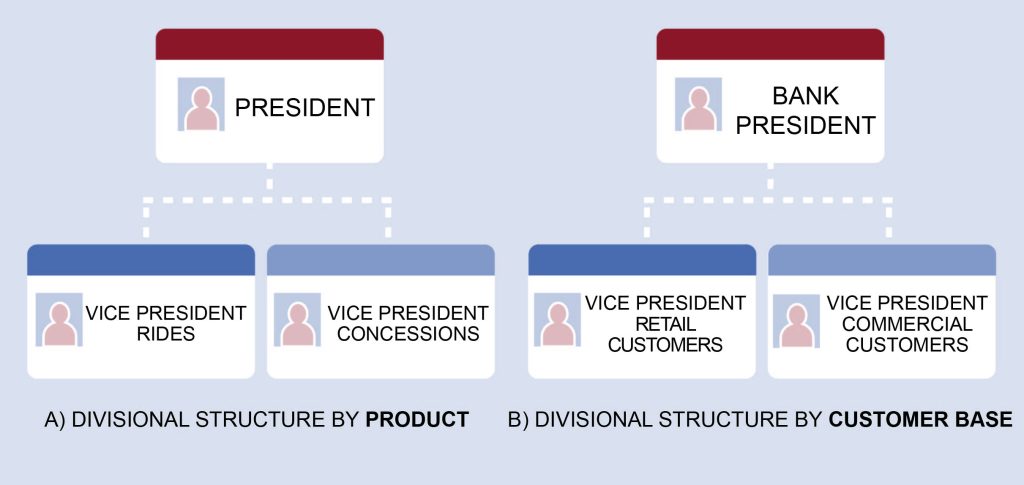
Over time, companies revise their organizational structures to accommodate growth and changes in the external environment. It’s not uncommon, for example, for a firm to adopt a functional structure in its early years. Then, as it becomes bigger and more complex, it might move to a divisional structure—perhaps to accommodate new products or to become more responsive to certain customers or geographical areas. Some companies might ultimately rely on a combination of functional and divisional structures. This could be a good approach for a credit card company that issues cards in both the United States and Europe. An outline of this firm’s organization chart might look like the one in Figure 9.5.
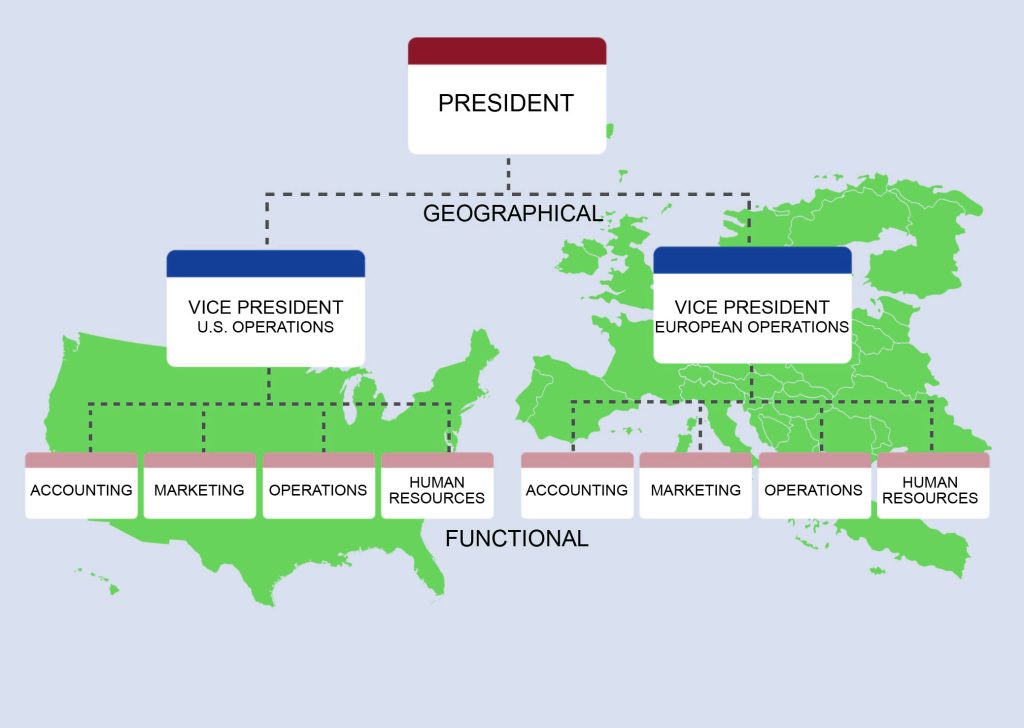
Chain of Command
The vertical connecting lines in the organization chart show the firm’s chain of command: the authority relationships among people working at different levels of the organization. That is to say, they show who reports to whom. When you’re examining an organization chart, you’ll probably want to know whether each person reports to one or more supervisors: to what extent, in other words, is there unity of command? To understand why unity of command is an important organizational feature, think about it from a personal standpoint. Would you want to report to more than one boss? What happens if you get conflicting directions? Whose directions would you follow?
There are, however, conditions under which an organization and its employees can benefit by violating the unity-of-command principle. Under a matrix structure, for example, employees from various functional areas (product design, manufacturing, finance, marketing, human resources, etc.) form teams to combine their skills in working on a specific project or product. This matrix organization chart might look like the one in the following figure.
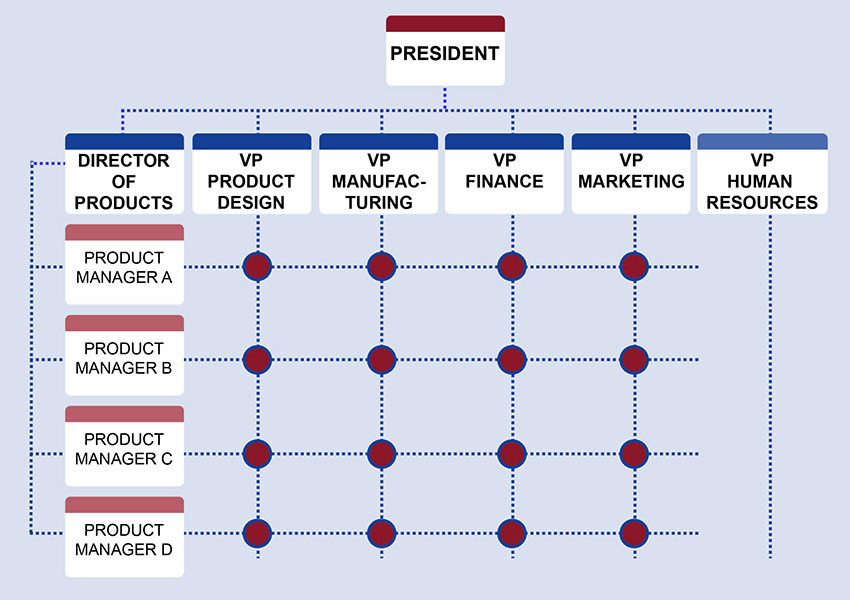
Nike sometimes uses this type of arrangement. To design new products, the company may create product teams made up of designers, marketers, and other specialists with expertise in particular sports categories—say, running shoes or basketball shoes. Each team member would be evaluated by both the team manager and the head of his or her functional department.
Span of Control
Another thing to notice about a firm’s chain of command is the number of layers between the top managerial position and the lowest managerial level. As a rule, new organizations have only a few layers of management—an organizational structure that’s often called flat. Let’s say, for instance, that a member of the Notes-4-You sales staff wanted to express concern about slow sales among a certain group of students. That person’s message would have to filter upward through only two management layers—the sales supervisor and the marketing manager—before reaching the president.
As a company grows, however, it tends to add more layers between the top and the bottom; that is, it gets taller. Added layers of management can slow down communication and decision making, causing the organization to become less efficient and productive. That’s one reason why many of today’s organizations are restructuring to become flatter.
There are trade-offs between the advantages and disadvantages of flat and tall organizations. Companies determine which trade-offs to make according to a principle called span of control, which measures the number of people reporting to a particular manager. If, for example, you remove layers of management to make your organization flatter, you end up increasing the number of people reporting to a particular supervisor. If you refer back to the organization chart for Notes-4-You, you’ll recall that, under your present structure, four managers report to you as the president: the heads of accounting, marketing, operations, and human resources. In turn, two of these managers have positions reporting to them: the advertising manager and sales supervisor report to the marketing manager, while the notetakers supervisor and the copiers supervisor report to the operations manager. Let’s say that you remove a layer of management by getting rid of the marketing and operations managers. Your organization would be flatter, but what would happen to your workload? As president, you’d now have six direct reports rather than four: accounting manager, advertising manager, sales manager, notetaker supervisor, copier supervisor, and human resources manager.
So what’s better—a narrow span of control (with few direct reports) or a wide span of control (with many direct reports)? The answer to this question depends on a number of factors, including frequency and type of interaction, proximity of subordinates, competence of both supervisor and subordinates, and the nature of the work being supervised. For example, you’d expect a much wider span of control at a nonprofit call center than in a hospital emergency room.
Delegating Authority
Given the tendency toward flatter organizations and wider spans of control, how do managers handle increased workloads? They must learn how to handle delegation—the process of entrusting work to subordinates. Unfortunately, many managers are reluctant to delegate. As a result, they not only overburden themselves with tasks that could be handled by others, but they also deny subordinates the opportunity to learn and develop new skills.
Responsibility and Authority
As owner of Notes-4-You, you’ll probably want to control every aspect of your business, especially during the start-up stage. But as the organization grows, you’ll have to assign responsibility for performing certain tasks to other people. You’ll also have to accept the fact that responsibility alone—the duty to perform a task—won’t be enough to get the job done. You’ll need to grant subordinates the authority they require to complete a task—that is, the power to make the necessary decisions. (And they’ll also need sufficient resources.) Ultimately, you’ll also hold your subordinates accountable for their performance.
Centralization and Decentralization
If and when your company expands (say, by offering note-taking services at other schools), you’ll have to decide whether most decisions should still be made by individuals at the top or delegated to lower-level employees. The first option, in which most decision making is concentrated at the top, is called centralization. The second option, which spreads decision making throughout the organization, is called decentralization.
Centralization has the advantage of consistency in decision-making. Since in a centralized model, key decisions are made by the same top managers, those decisions tend to be more uniform than if decisions were made by a variety of different people at lower levels in the organization. In most cases, decisions can also be made more quickly provided that top management does not try to control too many decisions. However, centralization has some important disadvantages. If top management makes virtually all key decisions, then lower-level managers will feel under-utilized and will not develop decision-making skills that would help them become promotable. An overly centralized model might also fail to consider information that only front-line employees have or might actually delay the decision-making process. Consider a case where the sales manager for an account is meeting with a customer representative who makes a request for a special sale price; the customer offers to buy 50% more product if the sales manager will reduce the price by 5% for one month. If the sales manager had to obtain approval from the head office, the opportunity might disappear before she could get approval – a competitor’s sales manager might be the customer’s next meeting.
An overly decentralized decision model has its risks as well. Imagine a case in which a company had adopted a geographically-based divisional structure and had greatly decentralized decision making. In order to expand its business, suppose one division decided to expand its territory into the geography of another division. If headquarters approval for such a move was not required, the divisions of the company might end up competing against each other, to the detriment of the organization as a whole. Companies that wish to maximize their potential must find the right balance between centralized and decentralized decision making.
Key Takeaways
- Managers coordinate the activities identified in the planning process among individuals, departments, or other units and allocate the resources needed to perform them.
- Typically, there are three levels of management: top managers, who are responsible for overall performance; middle managers, who report to top managers and oversee lower-level managers; and first-line managers, who supervise employees to make sure that work is performed correctly and on time.
- Management must develop an organizational structure, or arrangement of people within the organization, that will best achieve company goals.
- The process begins with specialization—dividing necessary tasks into jobs; the principle of grouping jobs into units is called departmentalization.
- Units are then grouped into an appropriate organizational structure. Functional organization groups people with comparable skills and tasks; divisional organization creates a structure composed of self-contained units based on product, customer, process, or geographical division. Forms of organizational division are often combined.
- An organization’s structure is represented in an organization chart—a diagram showing the interrelationships of its positions.
- This chart highlights the chain of command, or authority relationships among people working at different levels.
- It also shows the number of layers between the top and lowest managerial levels. An organization with few layers has a wide span of control, with each manager overseeing a large number of subordinates; with a narrow span of control, only a limited number of subordinates reports to each manager.
Chapter 9 Text References and Image Credits
Image Credits: Chapter 9
Figure 9.2: “Adidas Group geographic divisions.” Data source: Adidas Group Annual Report 2015. Retrieved from: http://www.adidas-group.com/en/investors/financial-reports/#/2015/ World map source: Mmikle. CC-BY-2.0. Retrieved from: https://commons.wikimedia.org/wiki/File:A_large_blank_world_map_with_oceans_marked_in_blue-edited.png Adidas logo © Adidas group. Retrieved from: https://commons.wikimedia.org/wiki/File:Adidas_Logo.svg
Figures 9.3 “An organizational chart for “Notes-4-Young.” Designed for Virginia Tech Libraries by Brian Craig. https://commons.wikimedia.org/wiki/Category:Figures_from_Fundamentals_of_Business_by_Skripak. Licensed CC BY 4.0.
Figure 9.4a-b “Organizational charts for divisional structures” Designed for Virginia Tech Libraries by Brian Craig. https://commons.wikimedia.org/wiki/Category:Figures_from_Fundamentals_of_Business_by_Skripak. Licensed CC BY 4.0.
Figure 9.5 “An organization with a combination of functional and divisional structures” Designed for Virginia Tech Libraries by Brian Craig. https://commons.wikimedia.org/wiki/Category:Figures_from_Fundamentals_of_Business_by_Skripak. Licensed CC BY 4.0.
Figure 9.6 “A chart of a matrix structure” Designed for Virginia Tech Libraries by Brian Craig. https://commons.wikimedia.org/wiki/Category:Figures_from_Fundamentals_of_Business_by_Skripak. Licensed CC BY 4.0.

